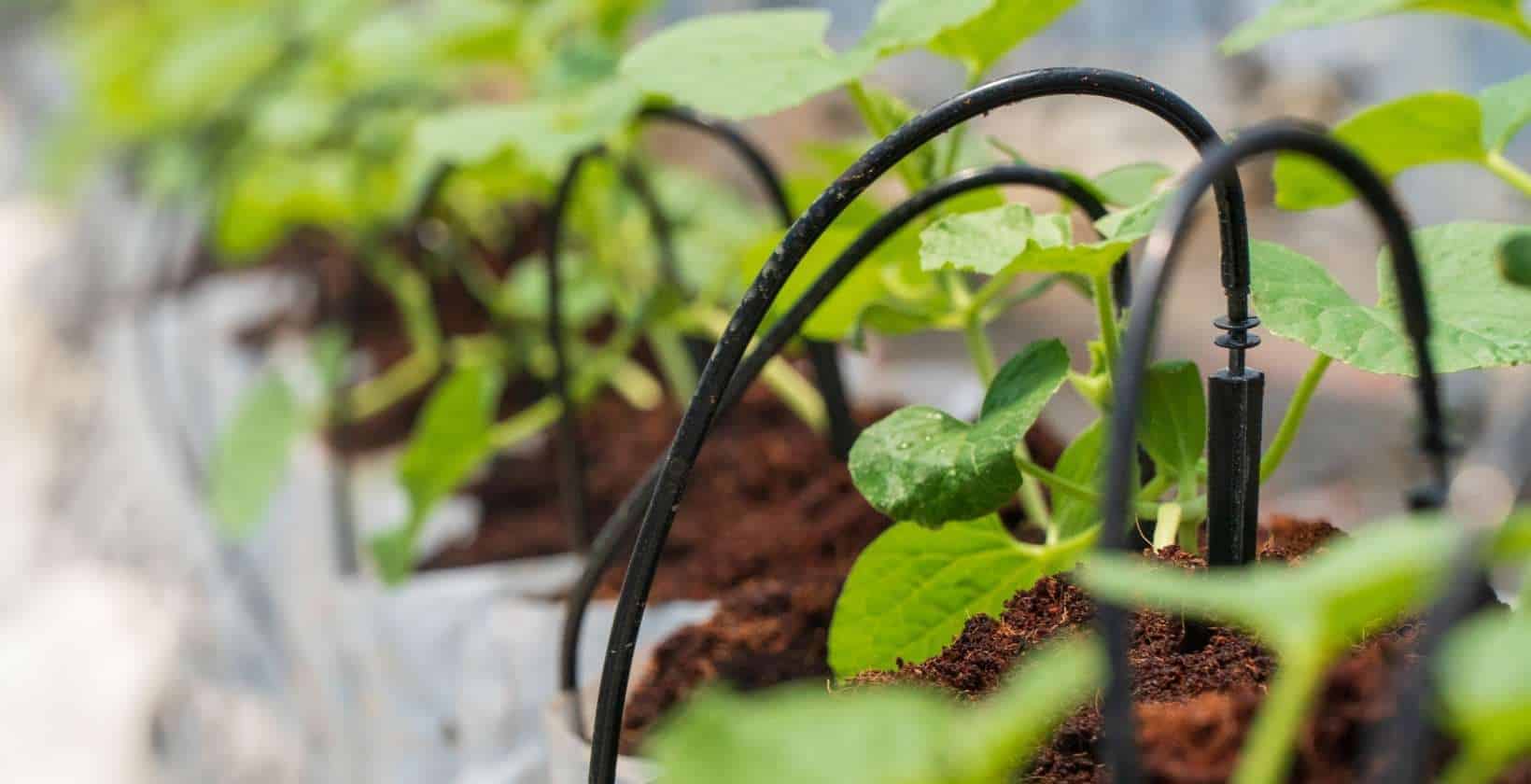
Drip Irrigation: Everything you need to know
Drip irrigation is the type of irrigation where water is released slowly into the designated area. Different parts of the landscape have different irrigation requirements, and therefore what works for one area might not work for another.
From selecting the right seasonal plants to installing an outdoor kitchen, our landscaping services can do it all for you. Contact us today for a stunning landscape!
Eden discusses drip irrigation systems in detail in this article – what they are, how they work, where they are used, the types of drip irrigation systems, benefits of drip irrigation, risks of drip irrigation and the possible cost of installing a drip irrigation system. Let us start with understanding what exactly drip irrigation is.
What is Drip Irrigation?
Drip irrigation, also known as trickle irrigation, is the method of irrigating plants where the water is directly applied or allowed to ‘drip’ to the roots of the plants. This can be done from above the surface of the soil or from below the surface of the soil. This irrigation method saves nutrients and water since a lot of water is not applied at once, which prevents the loss of nutrients due to runoff and water.
In drip irrigation, water is supplied to the plants through long tubes with small holes known as emitters that release water directly to the roots of the plants and do not apply water to the leaves of the plants, which is better for the health of the plants. The water application rate is slow in drip irrigation, which ensures that the plant roots absorb all the water and no water is wasted. Drip irrigation prevents water loss in another way as this method does not lose water to evaporation.

Where was Drip Irrigation first used?
Drip irrigation was first used in Ancient China, according to the Fan Shengzhi shu, which was a book on Chinese agriculture written in the first century BC. In this ancient text, the use of buried unglazed clay pots is described to irrigate crops. These pots were filled with water and then buried into the ground to release water slowly through their unglazed, porous surface.
Modern irrigation can be traced back to the 1860s in Germany, when researchers started experimenting with clay pipes for irrigation. These clay pipes were buried into the ground to create a system that resembled a drip irrigation system combined with a drainage system. This clay pipe experimentation was expanded upon for 50 years, and in the 1920s, this system started using perforated pipes.
How does Drip Irrigation distribute water?
A drip irrigation system takes water from a water source, a tank, cistern, well, or city water. Pipes or tubes are connected to this water source to take water from the source to the gardens. If your water source is a well or city water, you will need to install a regulator or a pressure control valve to control the amount of water released into the tubes.
Once the pipes and tubes transport the water to the garden, the water is distributed throughout the garden through emitters. Emitters can be of two forms – preset holes in the tube or a separate emitter plug that fits into the tube and resembles a small sprinkler head. Valves and regulators are used to control the flow of water in the pipes and to ensure moisture is evenly distributed throughout the area.
If you are a newbie in drip irrigation, then Eden recommends using a starter kit. These starter kits come in various sizes (small, medium, large) and types like garden bed kits, rose and shrub kits, individual plant kits, etc. These kits contain everything you will need to install the system, and they can be automated with a battery timer.
Drip irrigation applies water slowly compared to other irrigation systems, which means it needs to run longer. However, this type of irrigation applies water deeply; therefore, drip irrigation does not need to be used often. The frequency of drip irrigation can vary depending on the season.

Where can Drip Irrigation be used?
Drip systems are ideal for vegetable gardens, garden beds, hedges, and other areas where plants will flourish, like perennial gardens. They are not commonly utilized under lawns or grassy areas because the roots will jam the emitters when they grow into the tubes. Drip irrigation systems for under-lawn watering are available; however, frequent chemical injection is required in this case to keep the roots at bay.
Where plants are placed widely apart, online emitter systems work best. You can use them to water the root bowls of the plants solely. You may easily expand your drip system by adding more drippers, especially as your root zone expands and your plants grow.
Inline systems are ideal for median strip garden beds, landscape beds that are shaped intricately, and densely planted regions where overspray is a problem. Both methods are simple to set up and can be shaded from the sun by mulch.
What are the different types of Drip Irrigation?
There are different types of drip irrigation systems based on the kind of emitter they use. Eden explains the four main types of drip irrigation systems below.
- Porous Pipe Drip Irrigation System: The porous pipe drip system is also known as the soaker hose or drip hose irrigation system. These pipes are made from recycled car tires and are laid across the area that needs to be watered. When the spigot connecting the pipe is turned on, the water flows into the pipe and then is slowly released into the garden area through the pores in the pipe. This type of drip irrigation can be used to water small areas like flower beds and vegetable gardens. The benefit of using this soaker hose is that it can be easily moved from one location to another, and it is highly durable.
- Emitter Line Drip Irrigation System: The emitter line drip irrigation system is one of the most commonly used types. In this method, pre-installed tubes water the area where they are present through emitters that are evenly spaced (about 15 inches apart) along the length of the tubes. These pipes are easy to install and can be used in both smaller areas like garden beds and larger areas like lawns, unlike soaker pipes which can only be used in small areas. Also, the risk of clogging is lower with an emitter line drip irrigation system compared to soaker pipes. Since these are pre-installed tubes, they cannot be moved like the porous pipe and can only be used to irrigate the area they are installed in.
- Punch-in Drip Irrigation System: In the punch-in irrigation system, each emitter hole is to be hand punched in the tubing and then the emitters are fixed in these holes. This feature makes the punch-in drip irrigation system more customizable than the soaker hose and emitter line drip irrigation systems. This is because emitters can be placed anywhere along the length of the tubing, according to your convenience. Some emitters come with self-piercing barbs that add to the convenience of their placement. When a hole is not required anymore, it can be easily closed using goof plugs. The most basic emitter hole puncher starts as low as around $1 on Amazon. Along with this, you will need a drip tube which starts at around $6 for a drip tube with ¼ inch diameter and a length of 50 feet.
- Micro-misting Drip Irrigation System: Micro-misting, drip irrigation system is a combination of a regular drip irrigation system and a traditional sprinkler system. Like drip irrigation, micro-misting irrigation systems also apply water at low water pressure, but instead of applying water in drops, a micro-misting irrigation system applies water as a fanlike spray. These are suitable for large areas that need constant moisture and therefore are mostly used to irrigate orchards and vineyards. They differ from soaker hoses, emitter lines, and punch-in irrigation systems in the aspect of water conservation as they are prone to water loss due to evaporation, just like overhead sprinklers. They are usually installed on risers, but these risers are non-retractable, and therefore micro-misting irrigation systems cannot be used on lawns.
What are the benefits of using Drip Irrigation?
The benefits of using drip irrigation are as follows.
- It uses water efficiently and does not waste water due to excessive irrigation.
- The plants grow healthily since the water is applied to the roots directly and deeply.
- It prevents soil erosion and loss of nutrients due to runoff.
- It is easy to install and does not require excavation or other complex procedures.
- Overwatering plants encourages weeds and diseases, and drip irrigation prevents that with precise deep watering.
- Drip irrigation systems are flexible and can be installed in different areas like containers, differently shaped garden beds, and in raised beds.
- Drip irrigation systems also have minimum water loss due to evaporation and overspray.
- The connection for drip lines can be provided directly through the hose spigot eliminating the need to cut into the home line.
What are the risks of using Drip Irrigation?
The risks of using drip irrigation are as follows.
- Drip irrigation tubes run along the ground, and this can lead to a risk of tripping over them and falling when you are working in the landscape. The tubing should be staked to the ground to minimize this risk.
- The tubing can also be damaged when they are stepped on or when they are run over with a mower or a tiller. In regions that experience extreme heat, the tubing also begins to break down due to constant sun exposure.
- If drip irrigation systems are not installed correctly, you will face the risk of your plants drying out due to ineffective watering.
If you want to install a cost-effective and efficient irrigation system, then drip irrigation is the way to go. For a professional drip irrigation installation that guarantees complete effectiveness and a customized setup according to your landscape’s requirements, contact Eden.
From selecting the right seasonal plants to installing an outdoor kitchen, our landscaping services can do it all for you. Contact us today for a stunning landscape!

